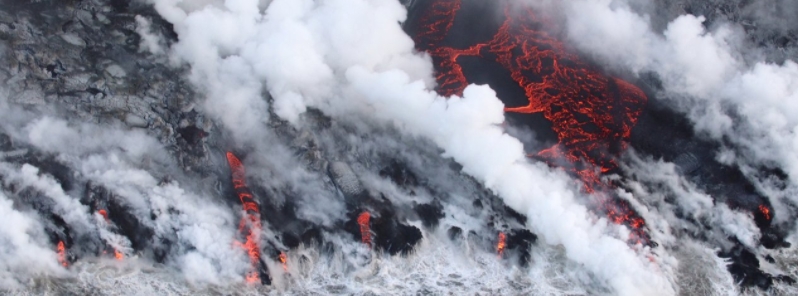Caldera collapse triggers large-scale volcanic eruptions

Researchers at NASA’s Jet Propulsion Laboratory in Southern California identified what triggers large-scale volcanic eruptions and the conditions that lead to them. Using data from the 2018 Kilauea eruption in Hawaii– its largest volcanic eruption in over 200 years– the scientists were able to identify that the collapse of the caldera led to the larger-than-normal event.
"Ultimately, what caused this eruption to be so much larger than normal was the collapse of the volcano’s caldera– the large, craterlike depression at the volcano’s summit," said lead author Alberto Roman.
"During a caldera collapse, a massive block of rock near the top of the volcano slides down into the volcano. As it slides, gets stuck on the jagged walls around it, and slides some more, the block of rock squeezes out more magma than would ordinarily be expelled."
The team wanted to know what caused the caldera to collapse in the first place, and the likely culprit were vents– located at a distance away from, and at a much lower elevation than the volcano's summit.
"Sometimes, volcanoes erupt at the summit, but an eruption can also occur when lava breaks through vents much lower down the volcano," co-author Paul Lundgren explained. "Eruption through these low-elevation vents likely led to the collapse of the caldera."
A large amount of magma can be emitted quickly through these vents, leaving the rocky floors and walls of the caldera without enough support. The rock from the caldera can collapse into the magma chamber. The rock then pressurizes the magma chambers as it falls.
For Kilauea, the researchers identified two of them, increasing the magma flow to vents and the total volume of the explosion. "The pressurization is akin to squeezing the water jug to force out the last little bit of water," JPL described.

The team also compared the model's forecasts to observations from similar eruptions triggered by caldera collapse at other volcanoes, and the results were consistent. The findings provide crucial insight into the possible severity of an eruption once it starts.
"f we see an eruption at a low-elevation vent, that is a red flag or warning that caldera collapse is possible," Roman said. "Similarly, if we detect earthquakes consistent with the slipping of the caldera rock block, we now know that the eruption will likely be much larger than usual."
Reference
"Dynamics of large effusive eruptions driven by caldera collapse" – Roman, A., & Lundgren, P. – Nature – https://doi.org/10.1038/s41586-021-03414-5
Abstract
The largest effusive basaltic eruptions are associated with caldera collapse and are manifest through quasi-periodic ground displacements and moderate-size earthquakes1,2,3, but the mechanism that governs their dynamics remains unclear. Here we provide a physical model that explains these processes, which accounts for both the quasi-periodic stick–slip collapse of the caldera roof and the long-term eruptive behaviour of the volcano. We show that it is the caldera collapse itself that sustains large effusive eruptions, and that triggering caldera collapse requires topography-generated pressures. The model is consistent with data from the 2018 Kīlauea eruption and allows us to estimate the properties of the plumbing system of the volcano. The results reveal that two reservoirs were active during the eruption, and place constraints on their connectivity. According to the model, the Kīlauea eruption stopped after slightly more than 60 percent of its potential caldera collapse events, possibly owing to the presence of the second reservoir. Finally, we show that this physical framework is generally applicable to the largest instrumented caldera collapse eruptions of the past fifty years.
Featured image credit: 2018 Kilauea Eruption. USGS

I remember this , yes, the USGS shut off the server feeds, and refused to show that data, deleting data, faking data, failing to report some blasts, and faking others, removing data of other events. They were taking issue with good researchers who understand this seismic activity better than they, and, they don’t like that. Omitting data, is not part of the charter team! they refused to upload the public images of the new, lower bigger caldera. Onya USGS, such manipulation of data is Criminal. could have cost many more lives. We had to rename you, US_S, is it possible they could answer this question? Understanding why?